|
|
|
Sort Order |
|
|
|
Items / Page
|
|
|
|
|
|
|
| Srl | Item |
| 1 |
ID:
154973
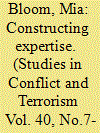

|
|
|
|
|
| Summary/Abstract |
The academic literature is divided with regard to whether terrorist recruits are dangerous masterminds, “malevolently creative,” and capable of perpetrating well-planned mass casualty attacks in the heart of European capitals. Or whether they are imbeciles, incapable of carrying out the most basic tasks, who mostly end up blowing themselves up by accident. This duality about the capabilities of terrorists is reflected in analyses of terrorist incidents. In fact, both depictions of terrorist recruits are accurate. Acuity and professionalism are not movement dependent (the same group may attract a variety of recruits) and might, instead, reflect a recruitment cycle that terrorist groups experience—one that alternates between labor-intensive and expertise-intensive periods of recruitment. The phases may shift because of external pressures (periods of territorial expansion/contraction) and opportunities (need for better quality recruits) with associated shifts in how groups use propaganda to attract a different quality of recruit during different periods of time. A possible first step toward hindering terrorist recruitment is to better understand the ways in which terrorist organizations work—where and when they recruit, whom they target, and the different propaganda messages used for selective/targeted recruitment. A clearer picture of the process could provide opportunities to counter a group's appeal, replenish their ranks, and inoculate vulnerable populations against recruitment. Case studies of three different terrorist organizations (Al Qaeda, the Islami State in Iraq and Syria [ISIS], and the Provisional Irish Republican Army [PIRA]) presented here posit that there exists a terrorism “recruitment cycle” that alternates between labor and expertise focus, uses different recruitment strategies and different propaganda messaging depending on this cycle.
|
|
|
|
|
|
|
|
|
|
|
|
|
|
|
|
| 2 |
ID:
082924
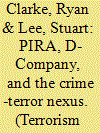

|
|
|
|
|
| Publication |
2008.
|
| Summary/Abstract |
This article compares and contrasts the Provisional Irish Republican Army (PIRA) and D-Company, two seemingly dissimilar organisations that nonetheless share some striking commonalities, especially in regards to the use of tactics that contradict their declared ideology in pursuit of a larger goal. First, the growing relationship between organised criminal syndicates and terror groups is discussed and Makarenko's well-known "Crime-Terror Continuum" introduced. Following this, a historical overview and an analysis of the organisational structure of the PIRA is provided and organisational models proposed. Further, the founding and development of D-Company is addressed in addition to the syndicate's intricate involvement in the 1993 Bombay Blasts. Similarly, organisational models are offered and conclusions drawn. This work then moves to a comparative analysis of the organisational and operating structure of the PIRA and D-Company and finishes with a brief conclusion. This article argues that although criminal syndicates and militant groups may have different organisation structures, the line that distinguishes their activities has begun to blur and the space between Makarenko's graduated levels is becoming smaller and less discernible, thus rendering her model obsolete.
|
|
|
|
|
|
|
|
|
|
|
|
|
|
|
|
| 3 |
ID:
165045
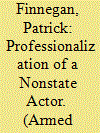

|
|
|
|
|
| Summary/Abstract |
Can nonstate militants professionalize? That is the core question of this piece. Discussions of professionalism have spread to the state military from civilian professions such as education, medicine, and law. This piece examines whether nonstate actors exhibit the same fundamental processes found within these state-based organizations. These fundamentals are the creation of a recognized internal ethos, which acts as a collective standard for those involved. A commitment to expertise and the punishment of those who do not reach these collective expectations reinforce this ethos. To answer this question, this piece examines the development of the Provisional Irish Republican Army (PIRA) during the Troubles. It highlights consistencies and inconsistencies with traditional forces and argues that groups like the PIRA can professionalize and increase their effectiveness in doing so. This widens the field of professionalism studies and provides an additional lens through which to examine nonstate groups.
|
|
|
|
|
|
|
|
|
|
|
|
|
|
|
|
| 4 |
ID:
013534


|
|
|
|
|
| Publication |
Autumn 1997.
|
| Description |
1-32
|
|
|
|
|
|
|
|
|
|
|
|
|
|
|
|
| 5 |
ID:
127692
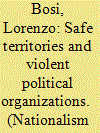

|
|
|
|
|
| Publication |
2013.
|
| Summary/Abstract |
This article assesses how the concept of safe territory can expand our understanding of the persistence of, and eventual disengagement from, violence by violent political organizations. The explanatory utility of this concept is demonstrated through an analysis of the cycles of political violence perpetrated by the Red Brigades in Italy and the Provisional Irish Republican Army in Northern Ireland. This work offers two main illustrative hypotheses. First, the opportunities provided by safe territories are not necessarily conducive to the continuation of political violence, although they facilitate its persistence over a long period of time. Second, the presence of safe territories, regardless of the ideology of the violent political organization, tends to enforce disengagement from political violence at the group, rather than the individual, level. Finally, the analytical intent in introducing the concept of safe territory is to contribute to spatial understandings of political violence.
|
|
|
|
|
|
|
|
|
|
|
|
|
|
|
|
| 6 |
ID:
181042
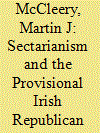

|
|
|
|
|
| Summary/Abstract |
This article addresses the scholarly debate over sectarianism and the Provisional Irish Republican Army’s (PIRA) campaign during the Northern Ireland Troubles. It argues that although there is much merit in the contributions made in this discourse, unfortunately, for, the most part, there is a lack of engagement with the deeper meaning of sectarianism. Consequently, it seeks to enhance the understanding of sectarianism within this arena before considering the nature of the PIRA campaign. By conducting a thorough analysis of the killings conducted by this organisation in the early years of the conflict it is ultimately concluded that, at the very least, PIRA tolerated, and likely sanctioned, sectarian violence from within its ranks.
|
|
|
|
|
|
|
|
|
|
|
|
|
|
|
|
| 7 |
ID:
148914
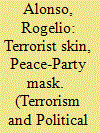

|
|
|
|
|
| Summary/Abstract |
The article analyses the political communication strategy adopted by Sinn Féin in order to legitimize the Provisional Irish Republican Army's (PIRA) terrorist campaign during their transition from violence into mainstream politics. Their endeavours to portray a triumphant republican movement in spite of the huge gap between strategic aims and achievements are examined. The political and social rehabilitation of violent Republicanism, and how their leaders have evolved from pariahs to celebrities, is also assessed. The role of the media and political elites, as well as the political discourse of the PIRA and Sinn Féin, is analysed in order to examine how the republican movement has tried to rewrite its past in an attempt to gain political and social legitimacy. Consequently, the myths reproduced by republicans to disguise their failures as historical compromises, reproducing a more benign interpretation of history which distorts the causes and consequences of terrorism, are critically assessed. The article will focus on the struggle for the legitimacy of the terrorist campaign and the propaganda system which, in the words of Garret FitzGerald (Irish Prime Minister between 1981 and 1987), has managed to turn the republican movement into the “peace party” despite murdering thousands of human beings.
|
|
|
|
|
|
|
|
|
|
|
|
|
|
|
|
| 8 |
ID:
125104


|
|
|
|
|
| Publication |
2013.
|
| Summary/Abstract |
The Provisional Irish Republican Army (PIRA), one of the best known and most researched terrorist organizations in history, has been comparatively assessed alongside various terrorist outfits from around the world. However, it has never been systematically compared with its most immediate rival, neighbour, and competitor, the lesser known Official Irish Republican Army (OIRA). This article addresses this scholarly gap and presents a thematic assessment of the similarities and differences between the two organisations in their respective post-ceasefire periods of 1972 and 1994. It proposes a new comparative approach to studying terrorist organisations in which knowledge about a better known entity (here, the PIRA) and its future trajectory is generated through a detailed assessment of the activities and developments of a not only more obscure case (here, the OIRA) but also, in many aspects, the most comparable case or cases. Such an approach could yield interesting results for the field of terrorism studies, which could still profit from in-depth, internal, case study analyses of specific terrorist organizations.
|
|
|
|
|
|
|
|
|
|
|
|
|
|
|
|
|
|
|
|
|